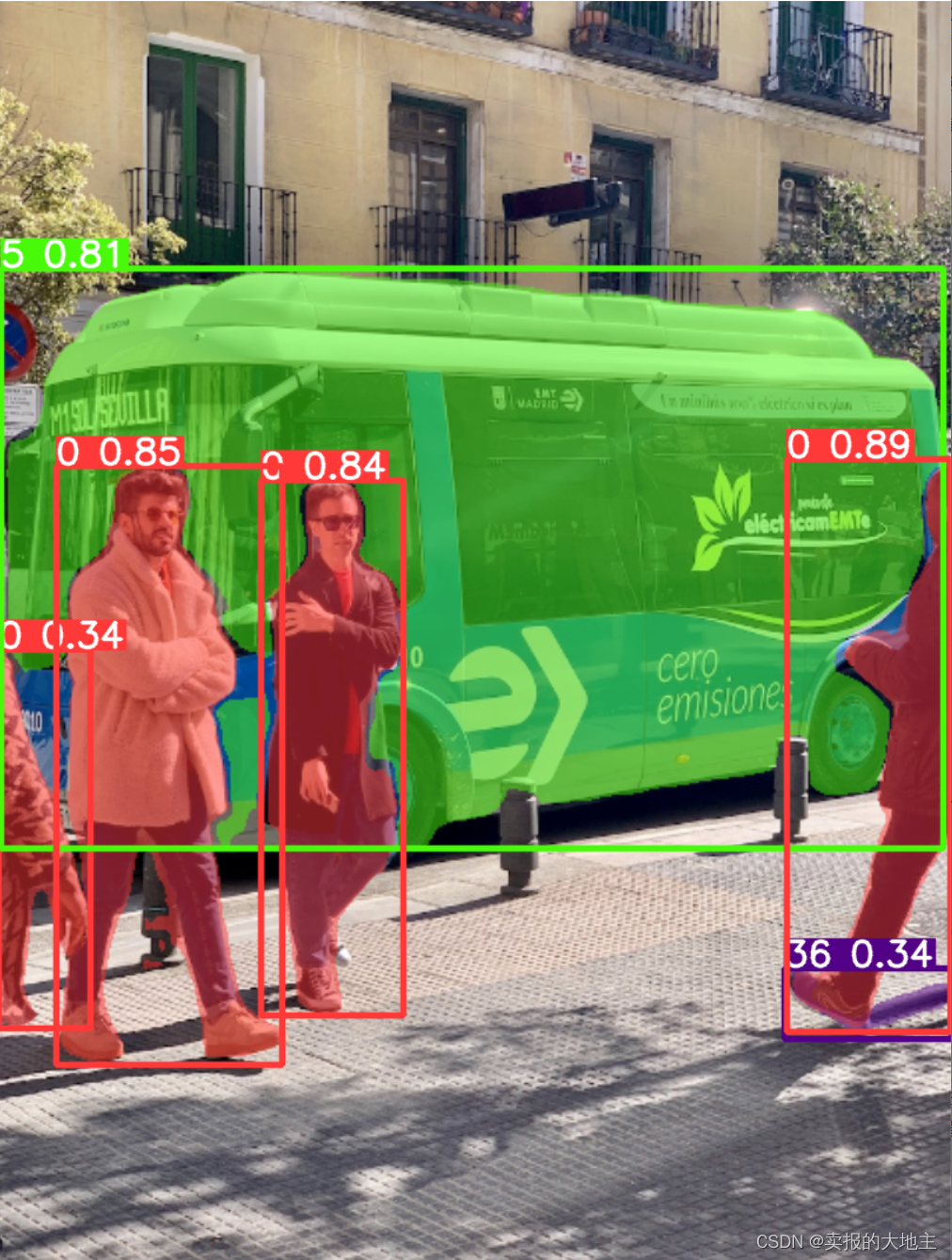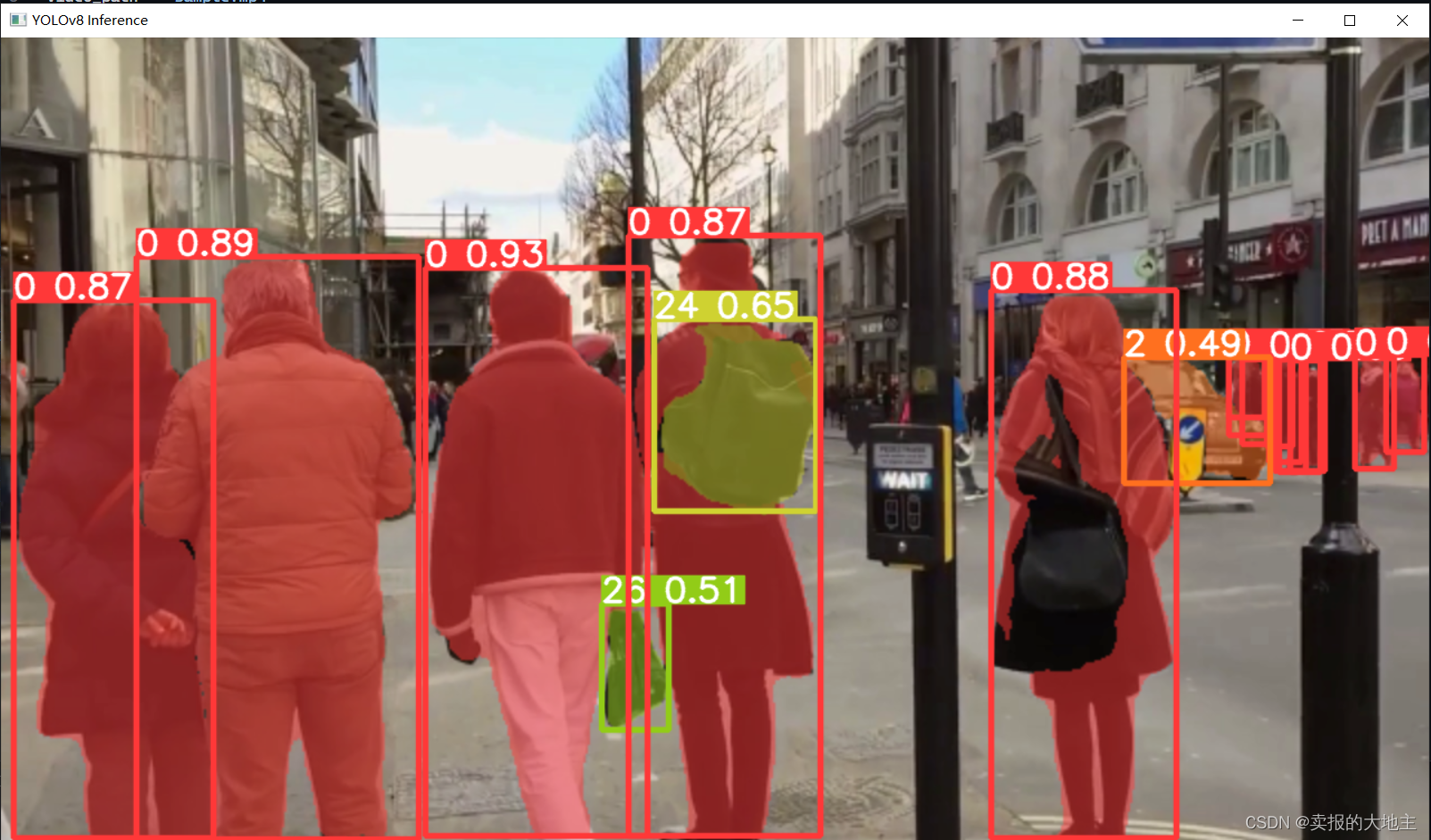predict模式用于在新图像或视频上使用经过训练的
YOLOv8
模型进行预测,在此模式下,模型从
checkpoint
文件加载,用户可以提供图像或视频来执行推理。模型预测输入图像或视频中对象的类别和位置。
from ultralytics import YOLO
from PIL import Image
import cv2
model = YOLO("model.pt")# 接受所有格式-image/dir/Path/URL/video/PIL/ndarray。0用于网络摄像头
results = model.predict(source="0")
results = model.predict(source="folder", show=True)# 展示预测结果# from PIL
im1 = Image.open("bus.jpg")
results = model.predict(source=im1, save=True)# 保存绘制的图像# from ndarray
im2 = cv2.imread("bus.jpg")
results = model.predict(source=im2, save=True, save_txt=True)# 将预测保存为标签# from list of PIL/ndarray
results = model.predict(source=[im1, im2])
YOLOv8
预测模式可以为各种任务生成预测,在使用流模式时返回结果对象列表或结果对象的内存高效生成器。通过在预测器的调用方法中传递
stream=True
来启用流模式。
stream=True
的流媒体模式应用于长视频或大型预测源,否则结果将在内存中累积并最终导致内存不足错误。
inputs =[img, img]# list of numpy arrays
results = model(inputs, stream=True)# generator of Results objectsfor result in results:
boxes = result.boxes # Boxes object for bbox outputs
masks = result.masks # Masks object for segmentation masks outputs
probs = result.probs # Class probabilities for classification outputs
相关参数如下:
KeyValueDescription
source
'ultralytics/assets'
source directory for images or videos
conf
0.25
object confidence threshold for detection
iou
0.7
intersection over union (IoU) threshold for NMS
half
False
use half precision (FP16)
device
None
device to run on, i.e. cuda device=0/1/2/3 or device=cpu
show
False
show results if possible
save
False
save images with results
save_txt
False
save results as .txt file
save_conf
False
save results with confidence scores
save_crop
False
save cropped images with results
hide_labels
False
hide labels
hide_conf
False
hide confidence scores
max_det
300
maximum number of detections per image
vid_stride
False
video frame-rate stride
line_thickness
3
bounding box thickness (pixels)
visualize
False
visualize model features
augment
False
apply image augmentation to prediction sources
agnostic_nms
False
class-agnostic NMS
retina_masks
False
use high-resolution segmentation masks
classes
None
filter results by class, i.e. class=0, or class=[0,2,3]
boxes
True
Show boxes in segmentation predictions
YOLOv8
可以接受各种输入源,如下表所示。这包括图像、URL、PIL图像、OpenCV、numpy数组、torch张量、CSV文件、视频、目录、全局、YouTube视频和流。该表指示每个源是否可以在流模式下使用stream=True✅以及每个源的示例参数。
sourcemodel(arg)typenotesimage
'im.jpg'
str
,
Path
URL
'https://ultralytics.com/images/bus.jpg'
str
screenshot
'screen'
str
PIL
Image.open('im.jpg')
PIL.Image
HWC, RGBOpenCV
cv2.imread('im.jpg')[:,:,::-1]
np.ndarray
HWC, BGR to RGBnumpy
np.zeros((640,1280,3))
np.ndarray
HWCtorch
torch.zeros(16,3,320,640)
torch.Tensor
BCHW, RGBCSV
'sources.csv'
str
,
Path
RTSP, RTMP, HTTPvideo ✅
'vid.mp4'
str
,
Path
directory ✅
'path/'
str
,
Path
glob ✅
'path/*.jpg'
str
Use
*
operatorYouTube ✅
'https://youtu.be/Zgi9g1ksQHc'
str
stream ✅
'rtsp://example.com/media.mp4'
str
RTSP, RTMP, HTTP
图像类型
Image SuffixesExample Predict CommandReference.bmp
yolo predict source=image.bmp
Microsoft BMP File Format.dng
yolo predict source=image.dng
Adobe DNG.jpeg
yolo predict source=image.jpeg
JPEG.jpg
yolo predict source=image.jpg
JPEG.mpo
yolo predict source=image.mpo
Multi Picture Object.png
yolo predict source=image.png
Portable Network Graphics.tif
yolo predict source=image.tif
Tag Image File Format.tiff
yolo predict source=image.tiff
Tag Image File Format.webp
yolo predict source=image.webp
WebP.pfm
yolo predict source=image.pfm
Portable FloatMap
视频类型
Video SuffixesExample Predict CommandReference.asf
yolo predict source=video.asf
Advanced Systems Format.avi
yolo predict source=video.avi
Audio Video Interleave.gif
yolo predict source=video.gif
Graphics Interchange Format.m4v
yolo predict source=video.m4v
MPEG-4 Part 14.mkv
yolo predict source=video.mkv
Matroska.mov
yolo predict source=video.mov
QuickTime File Format.mp4
yolo predict source=video.mp4
MPEG-4 Part 14 - Wikipedia.mpeg
yolo predict source=video.mpeg
MPEG-1 Part 2.mpg
yolo predict source=video.mpg
MPEG-1 Part 2.ts
yolo predict source=video.ts
MPEG Transport Stream.wmv
yolo predict source=video.wmv
Windows Media Video.webm
yolo predict source=video.webm
WebM Project
预测结果对象包含以下组件:
Results.boxes:
— 具有用于操作边界框的属性和方法的boxes
Results.masks:
— 用于索引掩码或获取段坐标的掩码对象
Results.probs:
— 包含类概率或logits
Results.orig_img:
— 载入内存的原始图像
Results.path:
— 包含输入图像路径的路径
默认情况下,每个结果都由一个torch. Tensor组成,它允许轻松操作:
results = results.cuda()
results = results.cpu()
results = results.to('cpu')
results = results.numpy()
from ultralytics import YOLO
import cv2
from ultralytics.yolo.utils.benchmarks import benchmark
model = YOLO("yolov8-seg.yaml").load('yolov8n-seg.pt')
results = model.predict(r'E:\CS\DL\yolo\yolov8study\bus.jpg')
boxes = results[0].boxes
masks = results[0].masks
probs = results[0].probs
print(f"boxes:{boxes[0]}")print(f"masks:{masks.xy }")print(f"probs:{probs}")
output:
image 1/1 E:\CS\DL\yolo\yolov8study\bus.jpg: 640x480 4 0s, 15, 136, 25.9ms
Speed: 4.0ms preprocess, 25.9ms inference, 10.0ms postprocess per image at shape (1, 3, 640, 640)
WARNING 'Boxes.boxes' is deprecated. Use 'Boxes.data' instead.
boxes:ultralytics.yolo.engine.results.Boxes object with attributes:
boxes: tensor([[670.1221, 389.6674, 809.4929, 876.5032, 0.8875, 0.0000]], device='cuda:0')
cls: tensor([0.], device='cuda:0')
conf: tensor([0.8875], device='cuda:0')
data: tensor([[670.1221, 389.6674, 809.4929, 876.5032, 0.8875, 0.0000]], device='cuda:0')
id: None
is_track: False
orig_shape: tensor([1080, 810], device='cuda:0')
shape: torch.Size([1, 6])
xywh: tensor([[739.8075, 633.0853, 139.3708, 486.8358]], device='cuda:0')
xywhn: tensor([[0.9133, 0.5862, 0.1721, 0.4508]], device='cuda:0')
xyxy: tensor([[670.1221, 389.6674, 809.4929, 876.5032]], device='cuda:0')
xyxyn: tensor([[0.8273, 0.3608, 0.9994, 0.8116]], device='cuda:0')
masks:[array([[804.94, 391.5],
[794.81, 401.62],
[794.81, 403.31],
[791.44, 406.69],
......
probs:None
我们可以使用Result对象的
plot()
函数在图像对象中绘制结果。它绘制在结果对象中找到的所有组件(框、掩码、分类日志等)
annotated_frame = results[0].plot()# Display the annotated frame
cv2.imshow("YOLOv8 Inference", annotated_frame)
cv2.waitKey()
cv2.destroyAllWindows()

使用OpenCV(cv2)和YOLOv8对视频帧运行推理的Python脚本。
import cv2
from ultralytics import YOLO
# Load the YOLOv8 model
model = model = YOLO("yolov8-seg.yaml").load('yolov8n-seg.pt')# Open the video file
video_path ="sample.mp4"
cap = cv2.VideoCapture(video_path)# Loop through the video frameswhile cap.isOpened():# Read a frame from the video
success, frame = cap.read()if success:# Run YOLOv8 inference on the frame
results = model(frame)# Visualize the results on the frame
annotated_frame = results[0].plot()# Display the annotated frame
cv2.imshow("YOLOv8 Inference", annotated_frame)# Break the loop if 'q' is pressedif cv2.waitKey(1)&0xFF==ord("q"):breakelse:# Break the loop if the end of the video is reachedbreak# Release the video capture object and close the display window
cap.release()
cv2.destroyAllWindows()

版权归原作者 卖报的大地主 所有, 如有侵权,请联系我们删除。